Uzbekistan Adventure
10 Days Private Tour of Tashkent - Urgench - Khiva - Kyzylkum Desert - Bukhara - Nurata - Safari Yurt Camp - Samarkand - Tashkent
Tour Type: Private guided tour, flexible and customizable
Transportation: Comfortable air-conditioned private car with driver
Accommodation: 3 to 4-star hotels, open to your own choice
Meals: 9 breakfasts
Code: TUZ03
Transportation: Comfortable air-conditioned private car with driver
Accommodation: 3 to 4-star hotels, open to your own choice
Meals: 9 breakfasts
Code: TUZ03
This trip can be customized to meet your individual needs!
From USD1749USD1539Free Inquiry
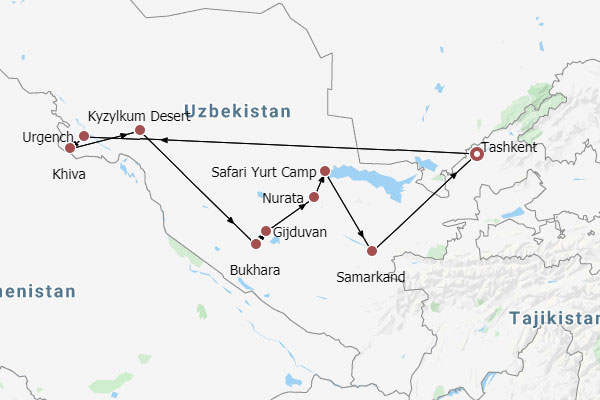
- Itinerary
- Prices
- Reviews
Trip Highlights
- Witness ancient paper-making techniques preserved in Koni Ghil Village in Samarkand.
- Admire the dazzling Islamic architecture in the UNESCO-listed inner city in Khiva.
- Wander through ancient alleys in Bukhara to explore how history blends with modern life.
- Feel the charm of Tashkent, where Central Asia-style buildings meet Soviet-era legacies.
- Venture into the Kyzylkum Desert on a camel’s back and sit around the bonfire to enjoy a folk song performance.
Expand All
Collapse All
Day 1 Tashkent Airport Pick-up; Visit Khast-Imam Complex, Chorsu Bazaar, State Museum of Applied Art
Street Performance in Uzbekistan
Established in the 2nd century BC, Tashkent was a key node on the Silk Road, but was devastated in the 1966 earthquake. Rebuilt by the Soviet Union, the city showcases a unique personality where traditional Islamic structures blend seamlessly with Soviet-era buildings. We will first roam across the city’s spiritual center, Khast-Imam Complex, where the Madrasah of Barak-Khan, Tilla Sheikh Mosque, and Abubakr Kaffal-Shashi Mausoleum demonstrate the most iconic Islamic architecture.
Passing the Islamic Institute of Imam al-Bukhari, the mecca of Muslims on the square, let’s dive into Tashkent’s biggest market, Chorsu Bazaar, once a vital Silk Road trading hub since the 11th century. Beneath the geometrically decorated ceiling, vendors’ calls mingle with the haggling of shoppers. Ascending to the second floor, you can capture a panoramic view of the concentric circle-arranged stalls. At its open-air sections, stalls overflow with intricate woodcarvings, silks, and hand-knotted carpets, and the air is filled with the irresistible aromas of freshly baked Uzbekistan bread, somsa, and sizzling kebabs.
Leave the bazaar and continue to the State Museum of Applied Art. Preserving more than 7,000 exhibits from the early 19th century to the present, the museum is like a chronicle written by silk, clay, and metal. Here, you’ll be dazzled by the exquisite ceramics, intricate jewelry, and the iconic Uzbek suzani embroidery decorated with intertwined motifs of stars, moons, flowers, and animals, which are said to bring blessings for the new couple.
Afterward, descend to the Soviet-style Tashkent subway stations, the first underground rail network in Central Asia, inaugurated in 1977. Initially operated as an anti-espionage system during the Cold War era, it has now been welcomed as a photographic spot for travelers. We will take the subway to the Independence Square Station, which looks like a European palace with its gleaming white marble columns and grand crystal chandeliers. Meeting the driver at the exit, we will wander through Independence Square and Amir Timur Square, and finally stop at the Earthquake Memorial, which was built to commemorate the victims of the 1966 earthquake. At the end of the day, you’ll be escorted to the hotel.
1. Entry Requirement: US citizens aged under 16 and over 55 enjoy visa-free entry to Uzbekistan, while other US visitors, along with citizens of 49 countries, must hold an e-visa (apply 1-2 weeks ahead). Passport holders from the EU and 66 countries, including the UK and Canada, are granted visa-free access.
2. Payment Method: While credit cards are accepted at big restaurants and stores within major tourist cities like Tashkent and Samarkand, the Uzbekistani som (UZS) dominates local bazaars. You can exchange some som in cash using Visa, Maestro cards, or USD cash at ATMs. USD 400 is sufficient for a 10-day trip for basic expenses.
Accommodation: Wyndham Tashkent (4 stars) or similar
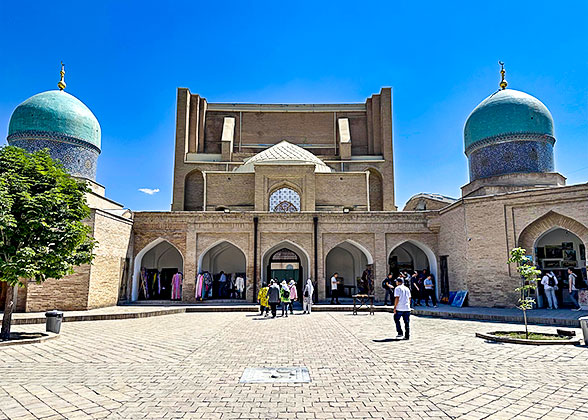
Khast-Imam Complex, Tashkent
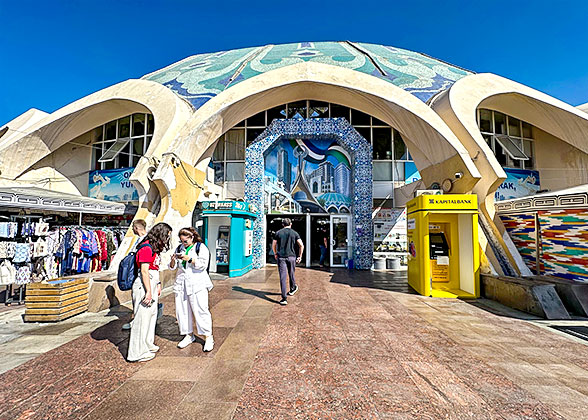
Chorsu Bazaar
Day 2 Fly to Urgench, Drive to Khiva: Kalta Minor Minaret, Tosh-Hovli Palace, Kunya-Ark
Khiva Old City
After a short break, with the accompaniment of our guide, let’s head to the UNESCO-listed Ichan Kala, the inner city of Khiva. We will first stop at two old Islamic schools, Muhammad Aminkhan Madrasah and Muhammad Aminkhan Madrasah, where you’ll be intrigued by the Kalta Minor Minaret with its astonishing façade clad in dazzling deep blue, turquoise, and white ceramic tiles. Commissioned by the Khan of Khiva in 1851, the minaret was planned to be 70 meters (230 feet) high, from which one can see Bukhara 400 km (248 mi) away. However, the construction stopped following the ruler’s death, leaving this unfinished 29-meter-high (95-foot) structure.
Then, step through a wooden door to admire 218 exquisitely carved pillars in Juma Mosque. Afterward, enter the serene courtyard of the Tosh-Hovli Palace, once the Khans’ residence, where you’ll be overwhelmed by its kaleidoscope of colors of interior decorations. The exquisitely carved stone columns showcase the charm of Central Asian craftsmanship in the 19th century. Beyond the architecture, you can see ancient copper, traditional Uzbek costumes, and some old photos in the palace’s small museum. Sometimes, you may stumble across a folk song performance in the palace. To its southwest, the Pakhlavan Makhmud Mausoleum shimmers with its turquoise central dome. Originally, it was a tomb of Pakhlavan Makhmud, a revered poet in Khiva, and later became a royal necropolis, whose every corner, including the sarcophagus, is covered with elaborate mosaic tiles.
Before dusk, drop by Khiva’s highest building, the Islam Khodja Minaret, and we will then head to the Kunya-Ark at the heart of the inner city. Enclosed by the meandering walls, it is regarded as “a city within the city”, which preserves the ancient throne room, mint, stables, and a Summer Mosque. The mosque’s walls are trimmed with blue-and-white floral tilework and caisson ceilings with a blend of brown, orange, and gold. Ascend the ramparts at sunset for an unforgettable panorama of Khiva's ancient skyline bathed in golden light. Finally, the guide and the driver will transfer you back to the hotel.
For energetic visitors, an evening stroll by yourself through Ichan-Kala is a good way to kill time. As the daytime vendors leave, the historic city sheds its commercial veneer, revealing its profound historical essence. Colorful lights illuminate arched doorways, lending the solemn religious structures an almost surreal, neo-futuristic ambiance. Wandering along the quiet, labyrinthine lanes, you may encounter street performers sharing haunting melodies and spirited dances of Uzbekistan.
Meals: Breakfast
Accommodation: Hotel Asia Khiva (3 stars) or similar
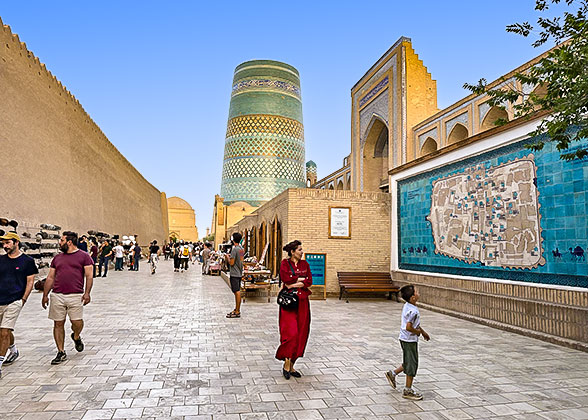
Ichan Kala of Khiva
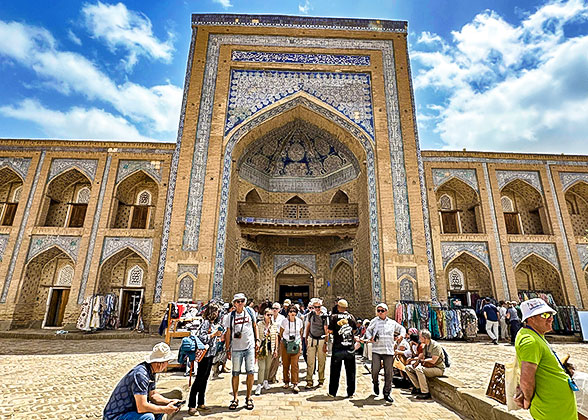
Muhammad Aminkhan Madrasah of Khiva
Day 3 Drive 7 Hours to Bukhara through the Kyzylkum Desert
Today, the driver will drive you along the Silk Road to Bukhara. This 480-kilometer (300-mile) traverse will take approximately 7-8 hours, during which you can witness the color transformation of the desert. When dawn breaks, we will approach the rust-red dunes. As the sun climbs higher, the desert takes on a warm, golden brown hue, while in the afternoon, the sands glow like smoldering embers. During the long journey, you’ll also see wind-sculpted ripples across the dunes and encounter wild camels traversing the arid expanse near the road.
► Tips:
1. Clothes to Pack: As the temperature varies widely during spring (March-June) and autumn (September-November), it is suggested that you dress in layers and prepare a jacket or thick coat. In scorching summer (July-August), the temperature may reach 40°C (104°F), so lightweight, breathable summer clothing is enough. Besides, sun-protective gear, such as a hat and sunscreen, is essential.
2. The road is quite bumpy in the desert, so please take some car sickness medicine beforehand. Moreover, we suggest you wear a dustproof mask for comfort in the dusty wind.
Upon arrival at Bukhara, you’ll be escorted to the handpicked hotel for check-in. Founded thousands of years ago by the Sogdian and Saka people, Bukhara was once the capital of the Samanid Empire during the 9th-10th centuries. However, unfortunately, it was razed by Genghis Khan in the 13th century. After about 100 years, the city rose from the ashes and flourished under the patronage of Timur. Considered the twin of Khiva, Bukhara distinguishes itself by preserving a deeply authentic medieval ambiance. Over the next two days, lose yourself in its labyrinthine alleys to explore its historical layers and experience the vibrant local life.
Meals: Breakfast
Accommodation: Volida Hotel Bukhara (3 stars) or similar
► Tips:
1. Clothes to Pack: As the temperature varies widely during spring (March-June) and autumn (September-November), it is suggested that you dress in layers and prepare a jacket or thick coat. In scorching summer (July-August), the temperature may reach 40°C (104°F), so lightweight, breathable summer clothing is enough. Besides, sun-protective gear, such as a hat and sunscreen, is essential.
2. The road is quite bumpy in the desert, so please take some car sickness medicine beforehand. Moreover, we suggest you wear a dustproof mask for comfort in the dusty wind.
Upon arrival at Bukhara, you’ll be escorted to the handpicked hotel for check-in. Founded thousands of years ago by the Sogdian and Saka people, Bukhara was once the capital of the Samanid Empire during the 9th-10th centuries. However, unfortunately, it was razed by Genghis Khan in the 13th century. After about 100 years, the city rose from the ashes and flourished under the patronage of Timur. Considered the twin of Khiva, Bukhara distinguishes itself by preserving a deeply authentic medieval ambiance. Over the next two days, lose yourself in its labyrinthine alleys to explore its historical layers and experience the vibrant local life.
Meals: Breakfast
Accommodation: Volida Hotel Bukhara (3 stars) or similar
Day 4 Bukhara: Lyabi Hauz Ensemble, Chor-Minor Madrasah, Trade Domes Market, Ark Fortress
Our Bukhara guide will meet you at the hotel in the morning and accompany you to today’s first stop, Lyabi Hauz Ensemble, at the heart of the old city. Its name, meaning "by the pond," is derived from the pool at the center, constructed in 1620 as a crucial water source during droughts. Around the pool stand one of Bukhara’s largest Islamic schools, two other religious buildings, and various teahouses and restaurants. In the shade of the square, you can see the bronze statue of the philosopher Hoja Nasruddin. Touch his right pocket, which is thought to bring wisdom.
Then, pass through the oldest mosque in Bukhara, Magoki-Attori Mosque, to the west, and stop at the Chor-Minor Madrasah. Actually, it isn’t a madrasah per se, but a surviving gatehouse. Drawing closer, you could see symbols of Islam, Christianity, Judaism, and Buddhism on the four turquoise-tiled towers. There is a sculpture of two storks on the top of the domes, which is believed to bring babies to couples.
Afterward, wander through the Trade Domes Market, filled with handicrafts, such as embroideries, wooden carvings, and miniatures. Nearby, two ancient Islamic institutions, Ulugh Beg Madrasah and Abdulaziz Khan Madrasah, will intrigue you with fancy façades decorated with blue and green mosaics. Adjacent, the Kalyan Minaret stands on the Poi-Kalyan Complex, soaring 47 meters (154 feet) high. This delicate tower was an execution place in the 18th century, where the condemned climbed its 105 steps for a final panoramic view before being cast down. Then head to Kalyan Mosque behind the minaret, which was once destroyed by Genghis Khan and later rebuilt in the 16th century and still operates as an Islamic school.
Dropping by the Miri-Arab Madrasah on its opposite side, let’s continue to the Ark Fortress, the bulwark built in the 1st century BC by the Sogdians, ancient Iranian-speaking people skilled in trading, to defend against northern nomads. Passing through its courtyards, once used to receive envoys, you’ll be intrigued by a restored shrine of Zoroastrians. The Sogdians believed that corpses would defile the earth, so they exposed the deceased on elevated platforms for the birds to eat. Later, the remaining bones would be collected in ceramic ossuaries, examples of which are exhibited in the fortress’s small museum. Ascending the ramparts, you’ll not only capture a panoramic view of the old city, but also witness the bones of the unrestored fortress.
Get down from the fortress’s wall, and head to the nearby Bolo Hauz Mosque to admire the 20 exquisite columns at its doorway. Then, admire the brickwork at the Samanid Mausoleum, one of the oldest and best-preserved structures in Bukhara. Finally, conclude the itinerary at the Chashma Ayub Mausoleum, where you can learn about the water supply system of Bukhara from ancient times. After that, the driver will send you back to the hotel.
 Recommended Restaurant (at your own expense):
Recommended Restaurant (at your own expense):
For authentic ambiance and cuisine, locals and travelers alike flock to Joy Chaikhana Lounge, housed within a restored caravanserai. Illuminated by colorful neon lights, the ground floor buzzes with energy, featuring occasional live traditional music and dance performances. For a quieter experience, head upstairs. Beyond the national staple, plov, consider savoring cheburek, a kind of Uzbek fried pastry whose deep-fried crust is filled with seasoned ground meat or mashed potatoes. Due to its popularity, make a reservation to secure a seat.
Average Cost per Person: USD 10-15. Mastercard, American Express, and Visa are acceptable.
Address: 2 Sarafon Street, Bukhara
Meals: Breakfast
Accommodation: Volida Hotel Bukhara (3 stars) or similar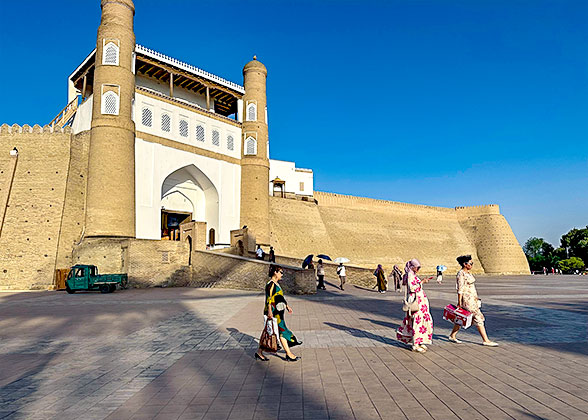
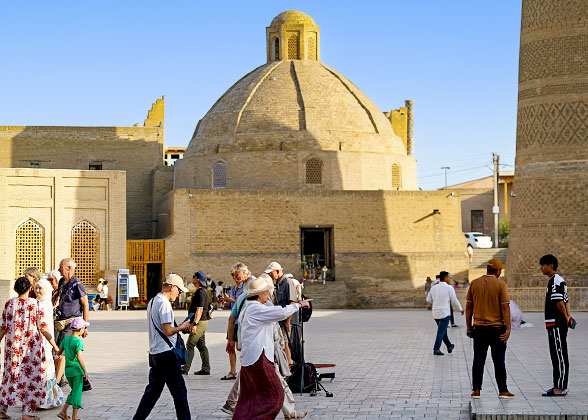
Then, pass through the oldest mosque in Bukhara, Magoki-Attori Mosque, to the west, and stop at the Chor-Minor Madrasah. Actually, it isn’t a madrasah per se, but a surviving gatehouse. Drawing closer, you could see symbols of Islam, Christianity, Judaism, and Buddhism on the four turquoise-tiled towers. There is a sculpture of two storks on the top of the domes, which is believed to bring babies to couples.
Afterward, wander through the Trade Domes Market, filled with handicrafts, such as embroideries, wooden carvings, and miniatures. Nearby, two ancient Islamic institutions, Ulugh Beg Madrasah and Abdulaziz Khan Madrasah, will intrigue you with fancy façades decorated with blue and green mosaics. Adjacent, the Kalyan Minaret stands on the Poi-Kalyan Complex, soaring 47 meters (154 feet) high. This delicate tower was an execution place in the 18th century, where the condemned climbed its 105 steps for a final panoramic view before being cast down. Then head to Kalyan Mosque behind the minaret, which was once destroyed by Genghis Khan and later rebuilt in the 16th century and still operates as an Islamic school.
Dropping by the Miri-Arab Madrasah on its opposite side, let’s continue to the Ark Fortress, the bulwark built in the 1st century BC by the Sogdians, ancient Iranian-speaking people skilled in trading, to defend against northern nomads. Passing through its courtyards, once used to receive envoys, you’ll be intrigued by a restored shrine of Zoroastrians. The Sogdians believed that corpses would defile the earth, so they exposed the deceased on elevated platforms for the birds to eat. Later, the remaining bones would be collected in ceramic ossuaries, examples of which are exhibited in the fortress’s small museum. Ascending the ramparts, you’ll not only capture a panoramic view of the old city, but also witness the bones of the unrestored fortress.
Get down from the fortress’s wall, and head to the nearby Bolo Hauz Mosque to admire the 20 exquisite columns at its doorway. Then, admire the brickwork at the Samanid Mausoleum, one of the oldest and best-preserved structures in Bukhara. Finally, conclude the itinerary at the Chashma Ayub Mausoleum, where you can learn about the water supply system of Bukhara from ancient times. After that, the driver will send you back to the hotel.
For authentic ambiance and cuisine, locals and travelers alike flock to Joy Chaikhana Lounge, housed within a restored caravanserai. Illuminated by colorful neon lights, the ground floor buzzes with energy, featuring occasional live traditional music and dance performances. For a quieter experience, head upstairs. Beyond the national staple, plov, consider savoring cheburek, a kind of Uzbek fried pastry whose deep-fried crust is filled with seasoned ground meat or mashed potatoes. Due to its popularity, make a reservation to secure a seat.
Average Cost per Person: USD 10-15. Mastercard, American Express, and Visa are acceptable.
Address: 2 Sarafon Street, Bukhara
Meals: Breakfast
Accommodation: Volida Hotel Bukhara (3 stars) or similar

Ark Fortress, Bukhara

Poi-Kalyan Architectural Complex
Day 5 Bukhara: Summer Palace, Memorial Complex of Bahouddin Naqshband, Chor-Bakr Necropolis
After picking you up at the hotel, our guide will accompany you to escape from the city's hustle and bustle to the suburb of Bukhara. First, stop at the Summer Palace (Sitorai Mohi Hosa), the summer residence of the last Emir of Bukhara. The palace mainly comprises the White Hall, a guesthouse, a harem, and a zoo, among which the White Hall is undoubtedly a crown jewel. Its walls and ceilings are built of snow-white plaster and adorned with bas-relief. A crystal chandelier from Poland hangs at the center, adding an exotic charm. Strolling through the shade of the garden, you may encounter iridescent blue peacocks. You can feed them, and the bold birds may even peck from your hands.
Afterward, let’s continue to the Memorial Complex of Bahouddin Naqshband, the resting place of a Sufi saint in the 14th century. After several reconstructions, the original tomb was expanded to a complex composed of graves of Khans, a madrasah, a central pond, and a mosque. Drive westward to the Chor-Bakr Necropolis rising from sunbaked plains dotted with mulberry groves to pay homage to the four saints from the Bakr family.
 Free Time Suggestion
Free Time Suggestion
In addition to its stunning Islamic architecture, Bukhara also boasts traditional crafts. If you are interested, spend your time wandering along the lanes teeming with workshops and artisan boutiques. Stop in front of the stalls of miniature masters to witness the drawing process. In Islam, miniature artists are thought to depict the world from the perspective of Allah. They painstakingly apply mineral pigments derived from malachite, lapis lazuli, and silver onto silk or vellum parchment, depicting scenes from religious epics and folklore. You can also follow the rhythmic clang of metalwork to a blacksmith's forge to witness how iron sheets are forged into ornaments engraved with elaborate patterns.
► Tip: Handicraft shops and souvenir stalls often quote higher prices to foreign travelers. Remember to cut off 50%-75% of the initial asking price to reach a fair deal.
Meals: Breakfast
Accommodation: Volida Hotel Bukhara (3 stars) or similar
Afterward, let’s continue to the Memorial Complex of Bahouddin Naqshband, the resting place of a Sufi saint in the 14th century. After several reconstructions, the original tomb was expanded to a complex composed of graves of Khans, a madrasah, a central pond, and a mosque. Drive westward to the Chor-Bakr Necropolis rising from sunbaked plains dotted with mulberry groves to pay homage to the four saints from the Bakr family.
★ Experience Uzbekistan Tea Culture at Silk Road Spices Teahouse
Then, we will return to the city center and relax at a local teahouse where a pot of tea and some desserts will be arranged for you. In the past, teahouses served as vital social hubs for Silk Road merchants to exchange news and negotiate affairs. Today, they remain places for post-meal relaxation and conversation. Stepping into the teahouse, which resembles a centuries-old caravanserai with wooden furniture and handmade carpets, you’ll catch a whiff of the spices. Order a pot of saffron tea, the signature brew with a warm amber hue, crafted from saffron and cardamom. Its initial subtle bitterness gives way to a lingering sweetness, complemented by the sesame brittle and assorted nuts. Leaving the teahouse, you’ll be transferred back to the hotel.In addition to its stunning Islamic architecture, Bukhara also boasts traditional crafts. If you are interested, spend your time wandering along the lanes teeming with workshops and artisan boutiques. Stop in front of the stalls of miniature masters to witness the drawing process. In Islam, miniature artists are thought to depict the world from the perspective of Allah. They painstakingly apply mineral pigments derived from malachite, lapis lazuli, and silver onto silk or vellum parchment, depicting scenes from religious epics and folklore. You can also follow the rhythmic clang of metalwork to a blacksmith's forge to witness how iron sheets are forged into ornaments engraved with elaborate patterns.
► Tip: Handicraft shops and souvenir stalls often quote higher prices to foreign travelers. Remember to cut off 50%-75% of the initial asking price to reach a fair deal.
Meals: Breakfast
Accommodation: Volida Hotel Bukhara (3 stars) or similar
Day 6 Drive 4 Hours to Desert Safari Yurt Camp; Stop by Gijduvan Workshop & Nurata Town
After saying goodbye to Bukhara, our driver will accompany you to Gijduvan to watch the pottery-making at a local workshop. The pottery wheel swirls on which the clay is gradually transformed into pots, cups, or plates. Some craftsmen are painting on the semi-finished products, while some are putting the glazed ones into the kiln. Then, stop at Nurata at the edge of the Kyzylkum Desert to visit its revered Holy Spring, which is said to have a healing function, and the surrounding mosques. Continue to the north, and we will have a glimpse of the petroglyphs and rock paintings at the Nurata pass. Another 1-hour drive will finally lead you to Kyzyl Kum Safari Yurt Camp. Upon arrival, check in at the camp and have a short break.
► Tips:
1. Since camels may be unsettled by bright colors, opt for earth-toned clothing, such as khaki, brown, and olive green, to blend with the environment. Besides, wear pants instead of shorts to minimize skin irritation from camels’ coarse hair.
2. We will spend a long time on the way, so we suggest you prepare some bottled water and snacks.
Meals: Breakfast
Accommodation: Kyzyl Kum Safari Yurt Camp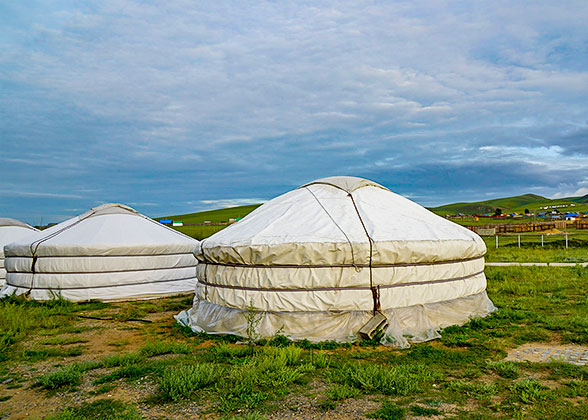
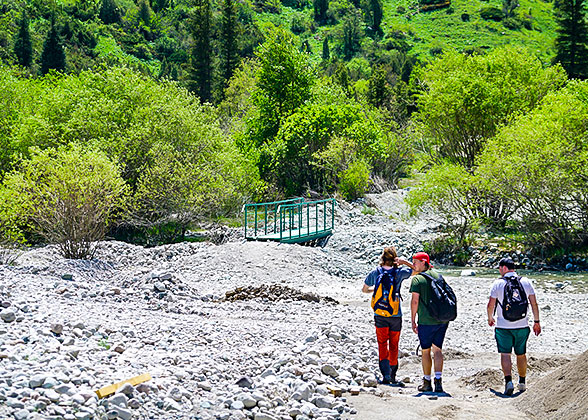
★ Ride a Camel and Wiggle with Uzbek Folk Songs
After that, embark on a camel trek through the rustling saxaul groves to nearby dunes where you can have a peek at the Aidarkul Lake. Listen to the chime of camel bells and admire the golden sunset; you can experience not only the distinct joy of the natural wonder but also a spiritual reflection. At night, gather around a crackling bonfire and enjoy local folk songs. As night deepens, prepare to be awestruck by the brilliance of the Milky Way arching through the unpolluted desert sky.► Tips:
1. Since camels may be unsettled by bright colors, opt for earth-toned clothing, such as khaki, brown, and olive green, to blend with the environment. Besides, wear pants instead of shorts to minimize skin irritation from camels’ coarse hair.
2. We will spend a long time on the way, so we suggest you prepare some bottled water and snacks.
Meals: Breakfast
Accommodation: Kyzyl Kum Safari Yurt Camp

Safari Yurt Camp in Uzbekisan

Nurata Pass
Day 7 Visit Aidarkul Lake, Drive 4 Hours to Samarkand
As the stunning desert sun rises, we will head to Aidarkul Lake, which is worthy of the name "the Blue Pearl" indeed. Formed in the spring floods of 1969, this sapphire-blue expanse now graces the southern fringe of the Kyzylkum Desert. Expanding over decades, Aidarkul Lake has become Uzbekistan's largest lake, serving as a crucial water source for the Mirzachul Steppe, a vast plain flanking the left bank of the Syr Darya River. Shielded by the surrounding desert, the lake remains untouched, nurturing a diverse array of wildlife. Reeds sway in the breeze, unveiling swans concealed in them. If you're lucky, you can witness white-tailed eagles fly over the water surface.
A 5-hour drive will then lead you southward to Samarkand. Have a good rest after checking into the hotel. Samarkand, a city that unfolds like an open-air museum, once served as the resplendent capital during the Timurid Empire (1370-1507), bequeathing various architectural masterpieces that surpass those of Khiva and Bukhara in scale and grandeur.
 Recommended Restaurant (at your own expense):
Recommended Restaurant (at your own expense):
Samarkand Restaurant is a good place to fill your stomach. Inside, it is adorned with Central Asian murals, figurines of Sogdian traders, and ceramics with classic Islamic patterns. For a unique atmosphere, dine at an outdoor table set within pavilions draped with gauze. Occasional live traditional music and dance performances also enhance the evening. Try manty, a kind of steamed dumpling filled with seasoned lamb and onions. Locals typically enjoy it with sour cream or yogurt. Tomato sauce is also offered for dipping.
Average Cost per Person: UZS 220,000 (USD 17)
Address: Pushkin St, 2, Samarkand 140100
Meals: Breakfast
Accommodation: Grand Samarkand Superior (4 stars) or similar
A 5-hour drive will then lead you southward to Samarkand. Have a good rest after checking into the hotel. Samarkand, a city that unfolds like an open-air museum, once served as the resplendent capital during the Timurid Empire (1370-1507), bequeathing various architectural masterpieces that surpass those of Khiva and Bukhara in scale and grandeur.
Samarkand Restaurant is a good place to fill your stomach. Inside, it is adorned with Central Asian murals, figurines of Sogdian traders, and ceramics with classic Islamic patterns. For a unique atmosphere, dine at an outdoor table set within pavilions draped with gauze. Occasional live traditional music and dance performances also enhance the evening. Try manty, a kind of steamed dumpling filled with seasoned lamb and onions. Locals typically enjoy it with sour cream or yogurt. Tomato sauce is also offered for dipping.
Average Cost per Person: UZS 220,000 (USD 17)
Address: Pushkin St, 2, Samarkand 140100
Meals: Breakfast
Accommodation: Grand Samarkand Superior (4 stars) or similar
Day 8 Samarkand: Registan Square, Bibi Khanym Mosque, Ulugbek Observatory, Shah-i-Zinda Necropolis
Our guide will meet you at the hotel in the morning and lead you to the first stop of today’s Samarkand sightseeing, Registan Square, at the city center. As a title page of Samarkand’s architecture, the square offers a comprehensive impression of the city’s grandeur with the surrounding madrasahs, among which the Sher-Dor Madrasah is the most outstanding. Its portal is adorned with two golden tigers pursuing deer beneath a rising sun. Legend tells that when the first settlers arrived at Samarkand, they met a leopard (often depicted as a tiger in art) and gained its permission to establish their home here. Later, locals enshrined the feline as the city's emblem.
Head southward to the Siyob Bazaar to lose yourself in the stalls overflowing with colorful oriental sweets, spices, and handicrafts, such as wood carvings and carpets. Jostling through the crowds, we will stop at the Bibi Khanym Mosque, one of Central Asia's most awe-inspiring Islamic monuments. Its colossal exterior features turquoise-glazed tiles that form Arabic calligraphy, floral scrolls, and geometric patterns, which are so dense that they make up a vast, ancient mosaic tapestry. Wearing solid-colored clothing for photos will be more effective to stand out against such a gaudy backdrop. Within its vast courtyard rests a towering marble Quran stand; women who want to conceive babies can crawl beneath the stand to fulfill their wishes, according to local lore.
Next, drive to the outskirts of the city and pay your respects to one of Central Asia’s most famous astronomers at the Ulugbek Observatory. Behind the statue of Mirzo Ulugbek, there is a remnant of the huge quadrant. You cannot believe that Ulugbek and his colleagues observed the positions of 1,080 stars using their naked eyes here. Nearby, there is a small museum that preserves the scientist’s frescoes, the observation instruments, and the model of the original three-tier observatory.
En route back to the city center, let’s have a glimpse at the Shah-i-Zinda Necropolis. Over 20 mausoleums flank the narrow alley, among which the earliest structures can date back to the 11th-12th centuries, while others were built during the 14th-15th centuries under the Timurids. During the golden hour in the afternoon, their façades covered with glazed tiles gleam in amber-hue lights. Standing in the middle of the alley against the light, you’ll capture a dramatic silhouette of these masterpieces. Finally, show your respect to Timur at the Gur-Emir Mausoleum. Though plain and simple outside, the building is stunning with honeycomb-like and starry decorations inside. Getting out of the mausoleum, you’ll be transferred back to the hotel.
Meals: Breakfast
Accommodation: Grand Samarkand Superior (4 stars) or similar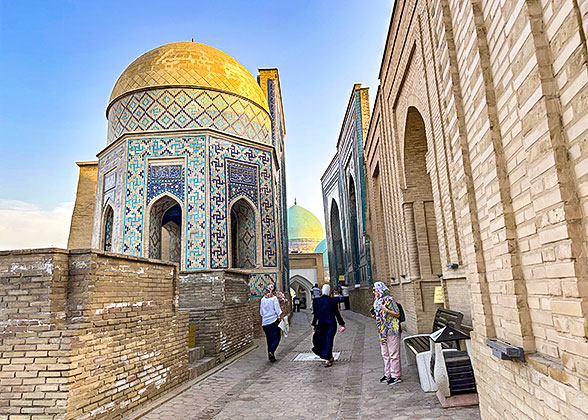
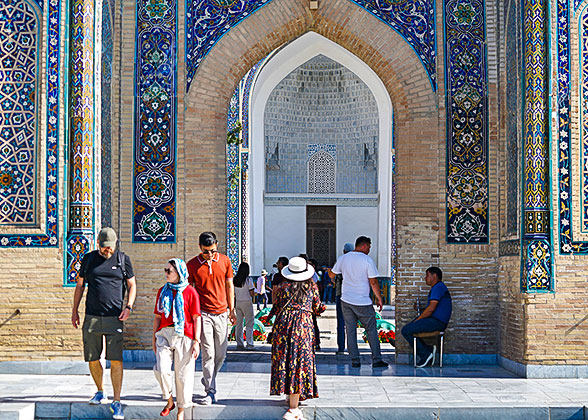
Head southward to the Siyob Bazaar to lose yourself in the stalls overflowing with colorful oriental sweets, spices, and handicrafts, such as wood carvings and carpets. Jostling through the crowds, we will stop at the Bibi Khanym Mosque, one of Central Asia's most awe-inspiring Islamic monuments. Its colossal exterior features turquoise-glazed tiles that form Arabic calligraphy, floral scrolls, and geometric patterns, which are so dense that they make up a vast, ancient mosaic tapestry. Wearing solid-colored clothing for photos will be more effective to stand out against such a gaudy backdrop. Within its vast courtyard rests a towering marble Quran stand; women who want to conceive babies can crawl beneath the stand to fulfill their wishes, according to local lore.
Next, drive to the outskirts of the city and pay your respects to one of Central Asia’s most famous astronomers at the Ulugbek Observatory. Behind the statue of Mirzo Ulugbek, there is a remnant of the huge quadrant. You cannot believe that Ulugbek and his colleagues observed the positions of 1,080 stars using their naked eyes here. Nearby, there is a small museum that preserves the scientist’s frescoes, the observation instruments, and the model of the original three-tier observatory.
En route back to the city center, let’s have a glimpse at the Shah-i-Zinda Necropolis. Over 20 mausoleums flank the narrow alley, among which the earliest structures can date back to the 11th-12th centuries, while others were built during the 14th-15th centuries under the Timurids. During the golden hour in the afternoon, their façades covered with glazed tiles gleam in amber-hue lights. Standing in the middle of the alley against the light, you’ll capture a dramatic silhouette of these masterpieces. Finally, show your respect to Timur at the Gur-Emir Mausoleum. Though plain and simple outside, the building is stunning with honeycomb-like and starry decorations inside. Getting out of the mausoleum, you’ll be transferred back to the hotel.
Meals: Breakfast
Accommodation: Grand Samarkand Superior (4 stars) or similar

Shah-i-Zinda Necropolis, Samarkand

Gur-Emir Mausoleum
Day 9 Samarkand: Afrasiab Museum, Traditional Paper-making; High-speed Train to Tashkent
Today, together with our guide, you’ll embark on a deep exploration of Samarkand. Dash northward to the Afrasiab Museum perched atop the ancient Afrasiab Hill, which once pulsed as the heart of Sogdian culture from the 6th century BC to the 13th century. Ravaged by Genghis Khan in 1220, the city remained buried until 1965. In the museum, you can see fragments of Sogdian contracts, seals, remnants of Chinese silk textiles, and Persian silver coins excavated from the ruins. The undisputed highlight is the remarkably 7th-century murals displayed in the "Hall of Ambassadors," which depict diplomatic scenes among the Sogdian and China, India, and the Turkic Khanates. After that, drop by the Tomb of Saint Daniel. The saint’s corpus is said to keep growing and has reached 17-18 meters (56-59 feet) long, beckoning many pilgrims. In addition, the healing spring in the courtyard is another attraction, which is believed to cure diseases.
We will leave you some free time to explore the village. Just stroll along the stream to see traditional waterwheels or have a short break with a cup of tea at the teahouse. If it’s September, you may have a chance to witness the harvest of mulberry branches. After finishing the Samarkand sightseeing, our driver will transfer you to the train station for a 2-hour high-speed train to Tashkent. Upon your arrival, the Tashkent driver will pick you up and escort you to the hotel.
 Where to Kill Time After Arriving at Tashkent (at your own expense)
Where to Kill Time After Arriving at Tashkent (at your own expense)
After settling down, consider visiting the Tashkent TV Tower. Ascend to its observation deck on the 6th floor for a 360-degree vista of the capital, costing UZS 50,000 (USD 3) for the ticket. If it’s at sunset, the city will be bathed in a golden hue. Around 6:30 PM, the tower will be illuminated with warm yellow lights, standing majestically against the evening sky.
Meals: Breakfast
Accommodation: Wyndham Tashkent (4 stars) or similar
★ Watch the Paper-Making Process at Koni Ghil Village
We’ll further drive to the Koni Ghil, the only village in Central Asia that has preserved the ancient technique of Samarkand papermaking. A millennium ago, this craft arrived in Samarkand via the Silk Road and gradually replaced parchment and Egyptian papyrus. Its prestige was so high that Timur decreed its exclusive use for adorning his mausoleum. It takes 3 days to finish a piece of paper. The harvested mulberry branches will first be soaked for one day and stripped of bark. The remainders will be boiled until soft and pounded into pulp on the second day. Then, scoop and settle the pulp on the bamboo screen to form a sheet. On the third day, the dried paper will be polished to be smooth with a cow horn or seashell. Browse the workshop, and you can find many paper-making handicrafts, such as garments, masks, and postcards.We will leave you some free time to explore the village. Just stroll along the stream to see traditional waterwheels or have a short break with a cup of tea at the teahouse. If it’s September, you may have a chance to witness the harvest of mulberry branches. After finishing the Samarkand sightseeing, our driver will transfer you to the train station for a 2-hour high-speed train to Tashkent. Upon your arrival, the Tashkent driver will pick you up and escort you to the hotel.
After settling down, consider visiting the Tashkent TV Tower. Ascend to its observation deck on the 6th floor for a 360-degree vista of the capital, costing UZS 50,000 (USD 3) for the ticket. If it’s at sunset, the city will be bathed in a golden hue. Around 6:30 PM, the tower will be illuminated with warm yellow lights, standing majestically against the evening sky.
Meals: Breakfast
Accommodation: Wyndham Tashkent (4 stars) or similar
Day 10 Departure from Tashkent, Airport See-off
At the end of this 10 days Uzbekistan itinerary, your driver will drop you off at Tashkent airport. Wish you fly home smoothly!
Want to continue to other Silk Road countries? We can tailor the journey to Kyrgyzstan to explore their ancient eagle hunting tradition or to Turkmenistan to have a peek at the “Door to Hell”, Darvaza Gas Crater. Consultation is welcomed any time, and we will reply within 12 hours!
Meals: Breakfast
Want to continue to other Silk Road countries? We can tailor the journey to Kyrgyzstan to explore their ancient eagle hunting tradition or to Turkmenistan to have a peek at the “Door to Hell”, Darvaza Gas Crater. Consultation is welcomed any time, and we will reply within 12 hours!
Meals: Breakfast
Expand All
Collapse All
This trip can be customized to meet your individual needs!
Tour Prices
Christmas & 2026 Specials: 12% off - Book before October 31, 2025
| Travelers | 2-3 travelers | 4-5 travelers |
|---|---|---|
| Year Round | USD2089 USD1838 | USD1749 USD1539 |
- Prices are per person on twin sharing.
- The prices in red reflect 12% discount.
- If you are a group of 6 people or more, we will offer a more favorable price by your group size.
Price Includes
- Economy class airfare of Tashkent - Urgench
- High-speed train fare of Samarkand - Tashkent
- Accommodation with daily breakfast at selected hotels
- Accommodation at the yurt camp near Aydarkul Lake
- Service of English-speaking local guides for sightseeing
- Service of a private air-conditioned car with a driver
- Entrance fees for all the mentioned sights visited
- Meals are as mentioned in the itinerary
- Free bottled water daily in the vehicle
Price Excludes
- International flight into and out of Uzbekistan
- Meals other than those mentioned in the itinerary
- Personal expenses (laundry, telephone, drinks, etc.)
- Tips for guides and drivers
- Personal travel insurance
- Uzbekistan visa fee
Itineraries you may also like:
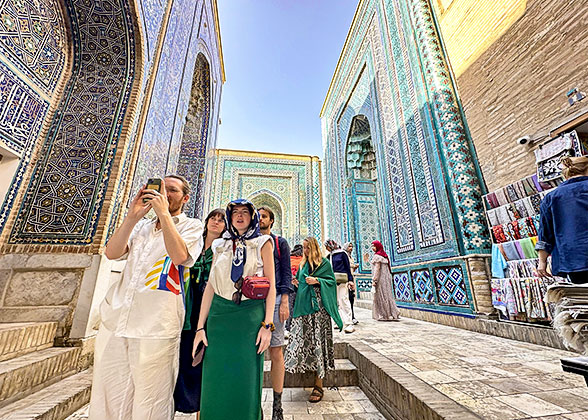 8 Days Tashkent - Samarkand - Bukhara - Kyzylkum Desert - Khiva - Urgench - Tashkent from USD1319
8 Days Tashkent - Samarkand - Bukhara - Kyzylkum Desert - Khiva - Urgench - Tashkent from USD1319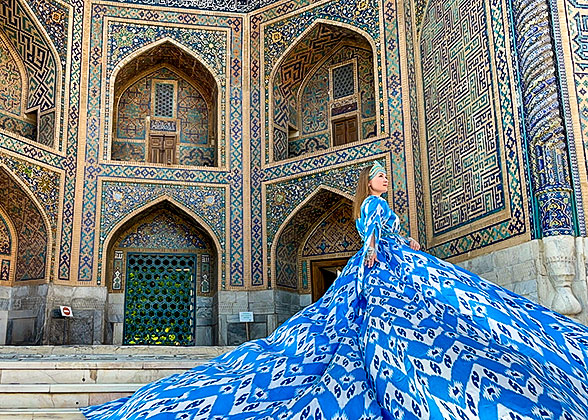 12 Days Tashkent - Nukus - Muynak - Nukus - Khiva - Kyzylkum Desert - Bukhara - Shakhrisabz - Samarkand - Tashkent from USD1803
12 Days Tashkent - Nukus - Muynak - Nukus - Khiva - Kyzylkum Desert - Bukhara - Shakhrisabz - Samarkand - Tashkent from USD1803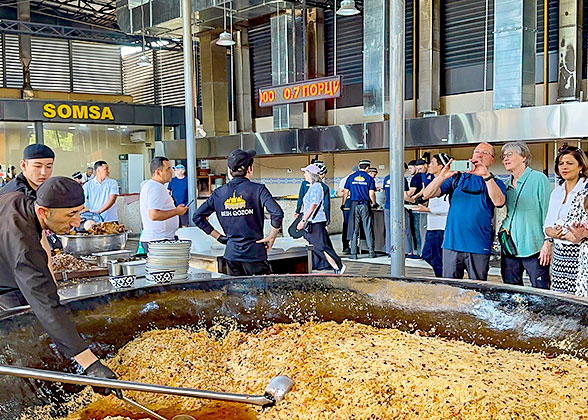 27 Days Almaty - Basshi - Jeti-Oguz - Tashkent - Khujand - Penjikent - Dushanbe - Kalai-Khumb - Dushanbe - Termez - Samarkand - Bukhara - Mary - Ashgabat - Darvaza - Khiva - Tashkent
27 Days Almaty - Basshi - Jeti-Oguz - Tashkent - Khujand - Penjikent - Dushanbe - Kalai-Khumb - Dushanbe - Termez - Samarkand - Bukhara - Mary - Ashgabat - Darvaza - Khiva - Tashkent
